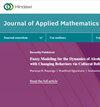实际行驶速度下基于链路的信号化动脉进程优化
IF 1.3
Q2 MATHEMATICS, APPLIED
引用次数: 8
摘要
带宽被定义为一个指定的运动通过动脉时的最大绿灯时间。在大多数先前的研究中,带宽被称为动脉带宽。在实践中,链路带宽和主干道带宽之间的平衡已被证明是优化协调信号授时计划的重要因素,因为并非所有驾驶员都需要通过主干道上的所有十字路口。本文提出了一种考虑实际车辆速度的最优链路带宽和最优主干道带宽的最优协调信号配时方案算法。引入加权链路带宽可达性作为评估优化结果有效性的附加度量。链路带宽优化是在改进梅塞尔算法的基础上建立的。主干道带宽优化算法在选择相序列时考虑了加权链路带宽可达性。在一个实例研究中证明了该算法在平衡考虑链路带宽和主干道带宽的情况下取得了许多改进。利用实际行程速度对初始信号配时方案进行了微调。评价结果表明,改进效果显著。本文章由计算机程序翻译,如有差异,请以英文原文为准。
Link-Based Signalized Arterial Progression Optimization with Practical Travel Speed
Bandwidth is defined as the maximum amount of green time for a designated movement as it passes through an arterial. In most previous studies, bandwidth has been referred to arterial bandwidth. In practice, a balance between link bandwidth and arterial bandwidth has proven to be important in optimizing coordinated signal timing plans, because not all drivers need to pass through all the intersections on an arterial. This study proposes an algorithm on how to obtain an optimal coordinated signal timing plan with both optimal link bandwidth and optimal arterial bandwidth considering practical vehicles’ speed. The weighted link bandwidth attainability is introduced as an additional measure of effectiveness for assessing the optimization results. The link bandwidth optimization is built based on the improvement of Messer’s algorithm about bandwidth optimization. The arterial bandwidth optimization algorithm takes into consideration the weighted link bandwidth attainability while selecting phase sequences. The proposed algorithm is demonstrated in a case study, and many improvements are archived when a balanced consideration is given to both link bandwidth and arterial bandwidth. Fine-tuning of initial signal timing plan is done using practical travel speed. The evaluation results show a rather significant improvement which is achieved.
求助全文
通过发布文献求助,成功后即可免费获取论文全文。
去求助
来源期刊

Journal of Applied Mathematics
MATHEMATICS, APPLIED-
CiteScore
2.70
自引率
0.00%
发文量
58
审稿时长
3.2 months
期刊介绍:
Journal of Applied Mathematics is a refereed journal devoted to the publication of original research papers and review articles in all areas of applied, computational, and industrial mathematics.
 求助内容:
求助内容: 应助结果提醒方式:
应助结果提醒方式:


